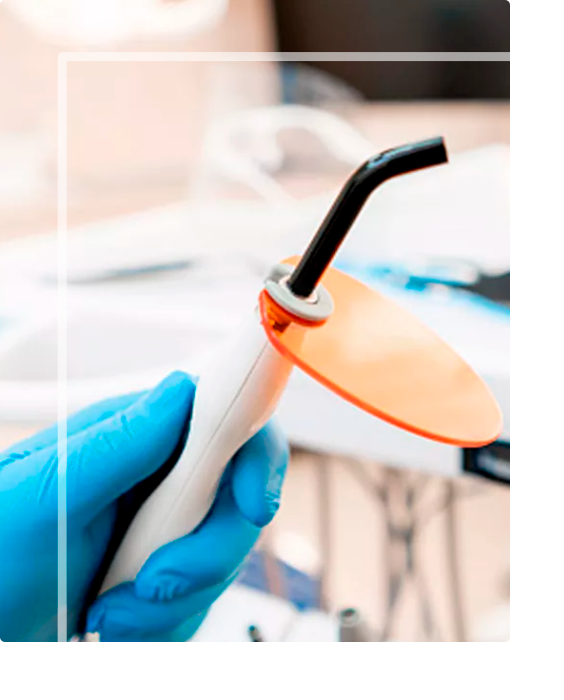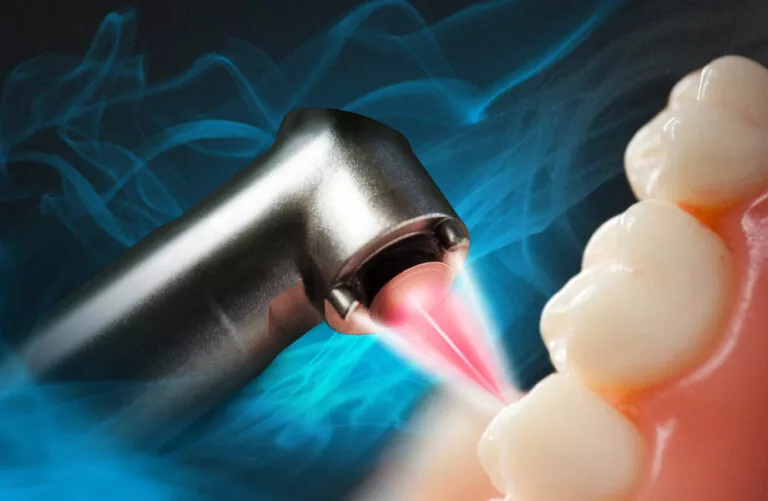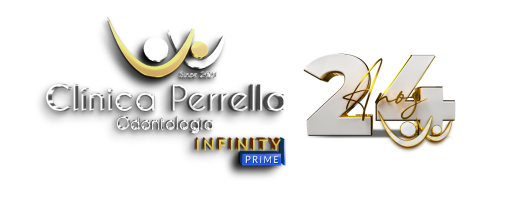Tenha novos motivos para sorrir.
TMJ Laser Therapy

Radioinduced Trismus Treatment
Trismus refers to a restricted mouth opening or tonic contraction of the masticatory muscles. Its etiology can be linked to various factors, including temporomandibular dysfunction, infectious diseases in the jaw, post-extraction complications, and radiotherapeutic treatment.Book an Appointment


It is one of the most common side effects of radiotherapy in the head and neck region.
Photobiomodulation works by stimulating muscle relaxation when applied to the affected musculature, improving painful symptoms and enhancing mouth opening and closing movements.
Treatment of Xerostomia
Xerostomia is a clinical condition characterized by reduced salivary flow. Its presence affects the physiology of the stomatognathic system. While radiotherapy for treating malignant neoplasms in the head and neck region is one treatment modality, it can lead to various complications, with xerostomia being one of the most prevalent. Low-level laser therapy works by increasing and stimulating salivary flow due to its bio-stimulating effect, thereby improving the patient’s quality of life
Treatment of Radiation Dermatitis:
Treatment of Bell's Facial Paralysis:
Treatment of Infant Stomatitis:
Infant stomatitis is a common and traumatic viral infection for children. It is characterized by multiple mouth ulcers, fever, and discomfort, preventing the child from eating and significantly impacting their health and quality of life.
Photobiomodulation is extremely effective in immediately controlling the pain caused by infant stomatitis due to its analgesic and anti-inflammatory potential, as well as accelerating lesion healing and quick recovery in children compared to conventional treatments.
Treatment of Paresthesia:
Paresthesia is a neurosensory disorder caused by neural tissue injury, primarily affecting the mental, lingual, and lower alveolar nerves. It results from factors such as dental surgeries, mandibular fractures, and anesthetic blocks. Photobiomodulation assists in peripheral nerve regeneration, providing sensory recovery and improving the patient’s quality of life.
Auxiliary Treatment for Alveolitis:
Tooth extraction is a routine oral surgery procedure. Among the most common postoperative complications is alveolitis. It is defined by postoperative pain around the extraction site, with increased severity occurring anytime between the first and third day after dental extraction, possibly presenting partial or total disintegration of the blood clot inside the socket.
Local conditions are characterized by initial clot loss or necrosis and an unpleasant odor. aPDT assists in alveolar area decontamination using low-power laser and 0.01% methylene blue (dye) to achieve an antimicrobial effect, enhancing the elimination of pathogenic microorganisms inside the socket.
Auxiliary Treatment for Trigeminal Neuralgia:
With a name not widely recognized among laypeople, trigeminal neuralgia is a common neurological condition in Brazil and ranks among the worst pains in the world. It consists of intense facial pain directly associated with a cranial nerve, the trigeminal nerve, which has both motor and sensory functions and is responsible for the sensitivity of this region.
Trigeminal neuralgia is classified as a chronic pain because it persists for more than three months. It tends to be debilitating, potentially isolating patients from their social and professional activities. Photobiomodulation effectively addresses this clinical situation by optimizing mitochondrial activity, modulating afferent nociceptive information, altering excitability and neural conduction, and modulating the inflammatory process, thus improving the patient’s quality of life.
Auxiliary Treatment for Oral Lichen Planus:
Low-level laser therapy has anti-inflammatory, analgesic, and biomodulatory properties and is used to treat various clinical conditions, one of which is Oral Lichen Planus. This clinical manifestation is characterized by chronic inflammation of the oral cavity lining, resulting in painful white or reddish lesions, closely resembling canker sores.
Since it is an autoimmune disease, meaning cells act against the body, this disease cannot be transmitted and has no cure. Its main symptoms include whitish spots in the mouth, swollen, red, and painful spots, open mouth sores, similar to canker sores, burning sensation in the mouth, excessive sensitivity to hot, acidic, or spicy food, inflamed gums, difficulty speaking, chewing, or swallowing. Low-level laser therapy controls and alleviates the main symptoms through its biomodulatory effect on the human body.
Peri-Implant Treatment
Low-level laser therapy is recommended in Implantology for its effect on tissue bio-stimulation, promoting osseointegration, which is its main desired effect. Laser therapy accelerates bone formation on the titanium surface of implants, allowing greater reliability in applying chewing forces on the prosthesis/implant set.
Applying low-level laser immediately after the surgical procedure and in the subsequent postoperative session provides more comfort to patients and accelerates repair and healing processes, also acting as an auxiliary in the treatment of peri-implantitis by decontaminating the implant surface through antimicrobial photodynamic therapy.
Treatment for Herpes Labialis:
With the arrival of spring and increased heat, many people end up overexposing themselves to the sun, which is the main villain for those with cold sores. Exposure to this situation can result in a new outbreak of the disease, which starts with an uncomfortable itching sensation on the lips, skin around the mouth, or inside it, leading to the formation of lesions resembling small fluid-filled blisters.
The disease caused by the herpes simplex virus (HSV-1) has no cure, but its current treatment has a strong ally: therapeutic laser, already used for treatment by dentists in dental specialties. Laser therapy reduces viral load, accelerates healing, relieves pain, and repairs traumatized tissues.
Canal Treatment with PDT:
One of the significant challenges in endodontics (root canal treatment) is intracanal bacterial control to achieve satisfactory endodontic treatment. Antimicrobial photodynamic therapy (aPDT) emerges as a significant ally to traditional endodontic treatment, significantly reducing the number of intracanal pathogenic microorganisms and contributing to solving cases, especially in the presence of resistant infections. The technique has proven to assist conventional endodontic treatment and is easily accessible.
Advantages of Laser Therapy in Pediatric Dentistry:
Low-level laser has analgesic, anti-inflammatory, and biomodulatory effects (ability to stimulate cells to reorganize) and, in pediatric dentistry, its actions are no different. Photobiomodulation serves as an important auxiliary tool in conventional pediatric dental treatments and is well-received by children.
In the pediatric dental clinic, it is used in stomatitis, reducing dental eruption symptoms, pre-anesthetic analgesia, canker sores, cold sores, angular cheilitis (inflammation of the corner of the lips), trismus (involuntary contractions), dentinal hypersensitivity, dental traumas, postoperative care, intracanal decontamination, and dental caries.
It is essential to emphasize that photobiomodulation has recently been applied in cases of facial paresthesias, commonly resulting from minor falls in early childhood, leading to fibrosis that sometimes does not respond to conventional treatments. Low-level laser therapy, besides functioning as an auxiliary treatment, aims to provide greater comfort for pediatric patients and is well-received by both children and their families.
Benefits of Laser Therapy in Orthodontics:
The use of low-level laser therapy is becoming increasingly common in dental clinics, bringing benefits to patients in various dental specialties. Orthodontics is one of the dental specialties benefiting from the effects of photobiomodulation, although this therapy is not yet widely recognized among specialists in the field.
Low-level laser therapy can be used in orthodontics for bone repair after rapid maxillary expansion, pain during orthodontic movement, assisting in tooth movement during proposed treatment, and repairing traumatic ulcers caused by orthodontic appliances. In orthodontics, photobiomodulation has its indications, contributing as an auxiliary to the treatment evolution, resulting in benefits for the professional and the patient.
Want to learn more about Laser Therapy? CLICK HERE and speak with our specialists.
SEE MORE TREATMENTS BY CLICKING HERE.
FOLLOW US ON SOCIAL MEDIA:
Dental Implant Specialist
Experienced Implantologists, highly trained staff, and state-of-the-art technology. All designed with your safety in mind.
Facilities
We have five treatment rooms, one specifically for post-surgical care to ensure the patient's complete recovery.
Human-Centered Treatment
Our entire team is dedicated to restoring happiness, self-esteem, chewing strength, and quality of life for you!
Wheelchair Accessibility
Accessibility for wheelchair patients: elevator access, level flooring, and restrooms equipped for your comfort and safety.
On-Site Parking
For the enhanced comfort and convenience of our patients, we offer on-site parking.
Testimonials
Genuine testimonials from patients who found their best smile with Perrella Dental Clinic!
Trustindex verifica se a fonte original da avaliação é Google. Fiquei maravilhada com todo atendimento da clínica Perrela e estrutura de primeiro mundo,desde o início do atendimento com a Cris, estacionamento com atendimento ímpar e todo aconchego que vcs nos recebeu. Todo carinho e atenção da Dra Helen , atendimento da Cecília / Katia em fazer o melhor e o Dr Renato que iniciou o canal um fofo, Dr Gabriel mãos de fada nem senti rsrs, as meninas da recepção muito atenciosas e ao Dr Murilo e a Dra Débora meus parabéns, por essa equipe maravilhosa . Sentindo se cuidada.Trustindex verifica se a fonte original da avaliação é Google. Ótimo atendimento.Trustindex verifica se a fonte original da avaliação é Google. Tudo de mais moderno no tratamento odontológico. Atendimento perfeito com muita simpatia.Trustindex verifica se a fonte original da avaliação é Google. Excelente local. Você é tratado com todo respeito,e atenção que merece. Profissionais mais que capacitados,para atender da melhor maneira possívelTrustindex verifica se a fonte original da avaliação é Google. Ótimo atendimento. Ótimos profissionais!!Trustindex verifica se a fonte original da avaliação é Google. Sou paciente da Clínica Odontológica Perrella e sempre fui muito bem atendida. A equipe é muito profissional e atenciosa, e os procedimentos são sempre realizados com muito cuidado e atenção. Estou satisfeita com os resultados e recomendo a clínica para todos que buscam um atendimento de qualidade, zelo, cuidado para um sorriso melhor. Parabéns para toda a equipe.





